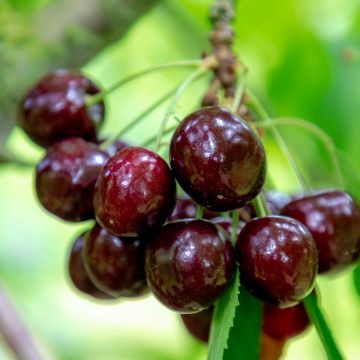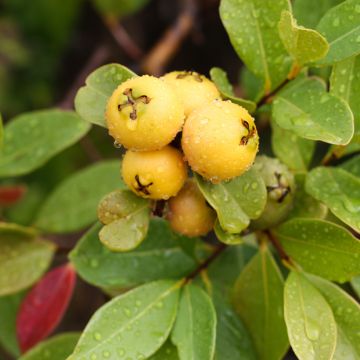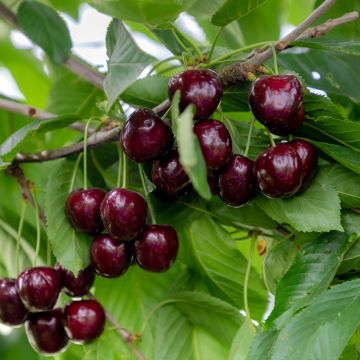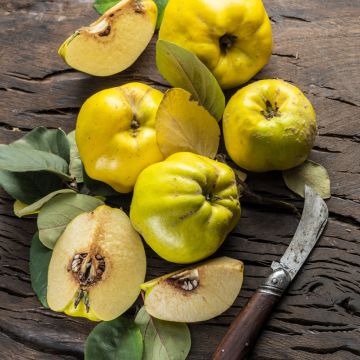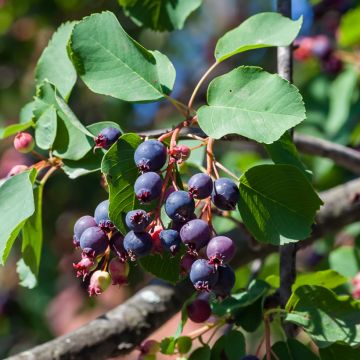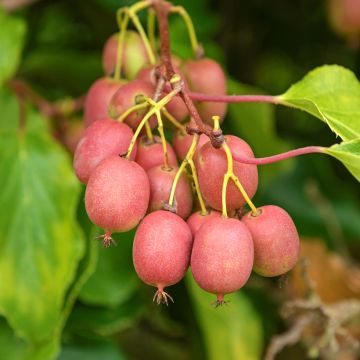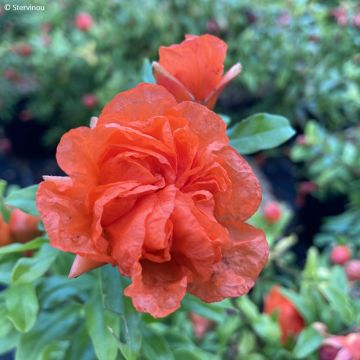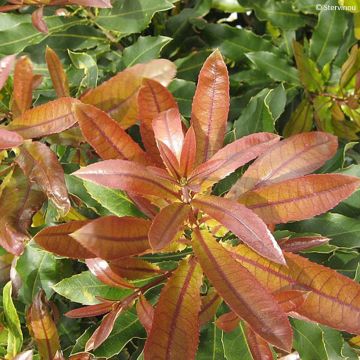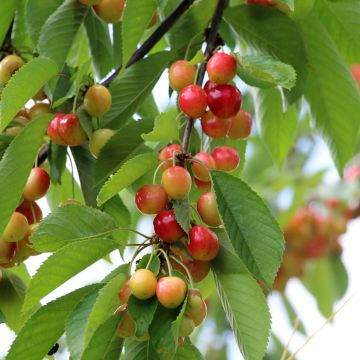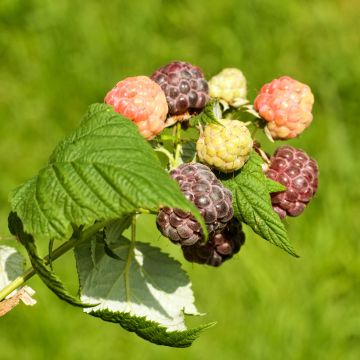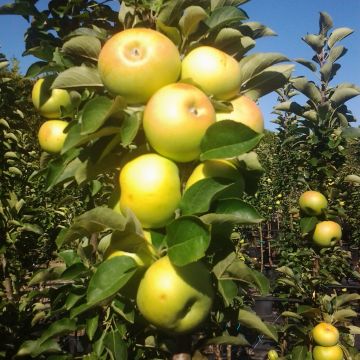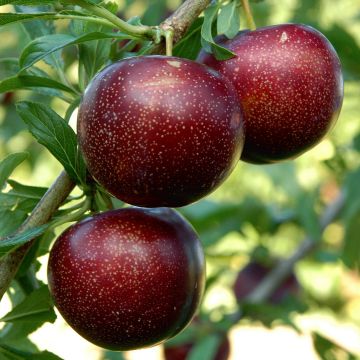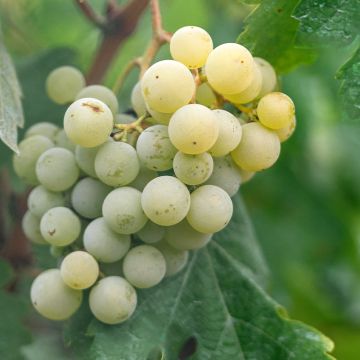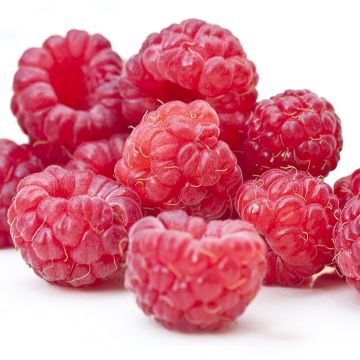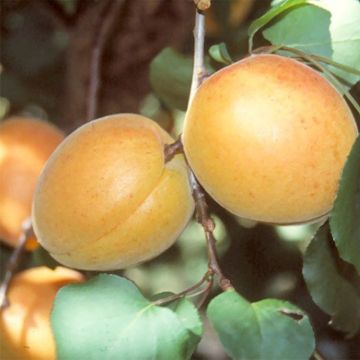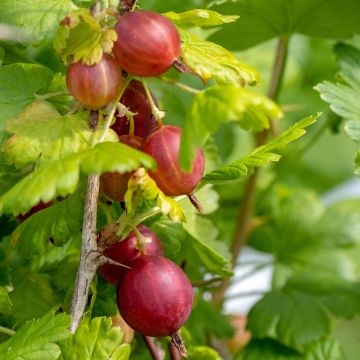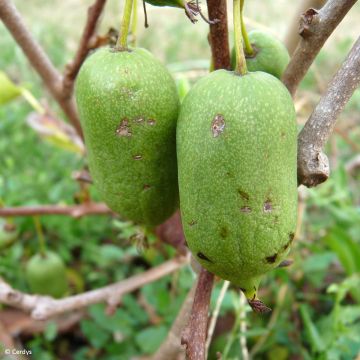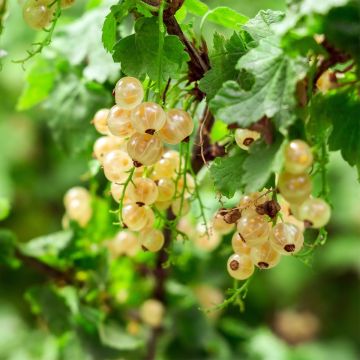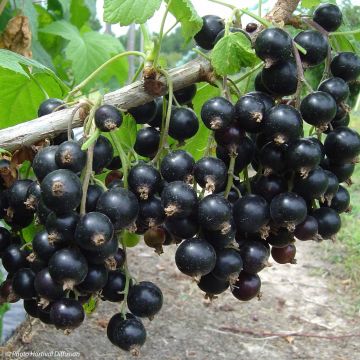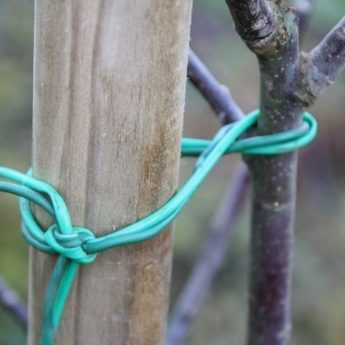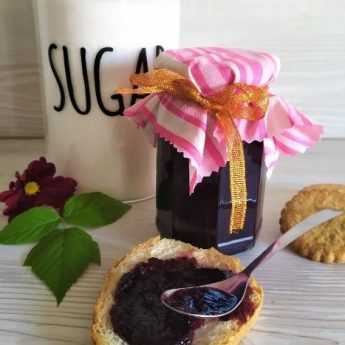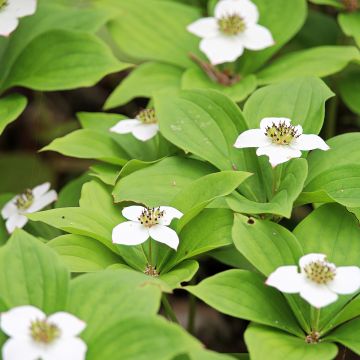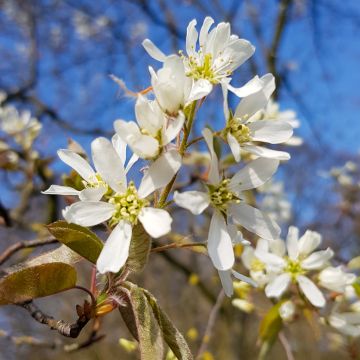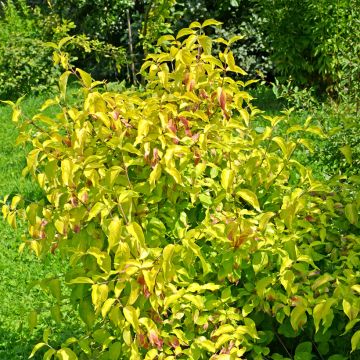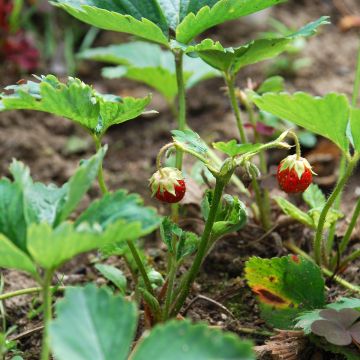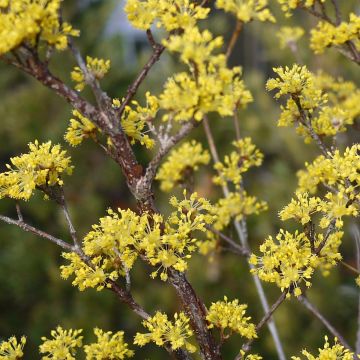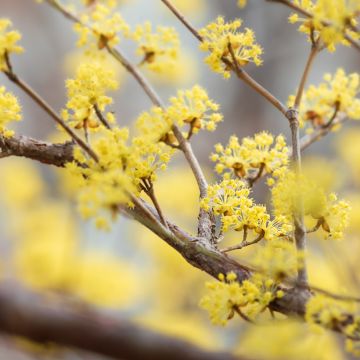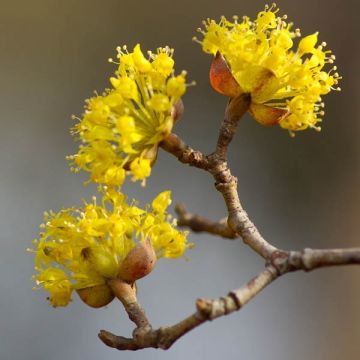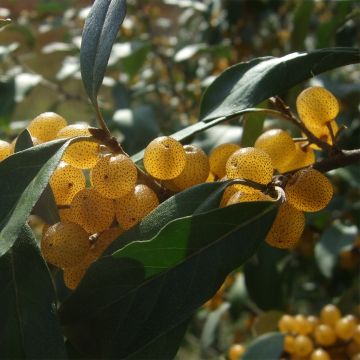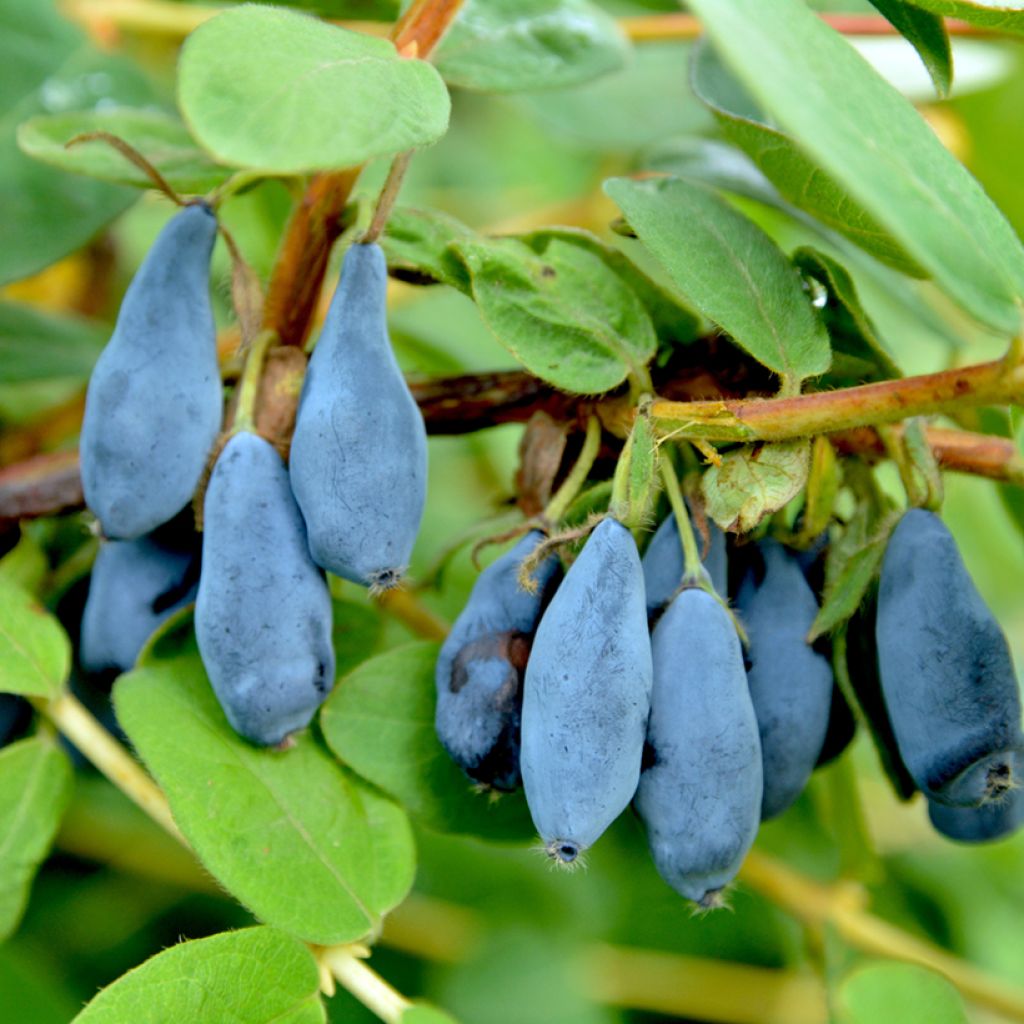

Honeyberry Regina - Lonicera caerulea var. kamtschatica
Honeyberry Regina - Lonicera caerulea var. kamtschatica
Lonicera caerulea var. kamtschatica Regina
Honeyberry, Haskap, Blue Honeysuckle
Why not try an alternative variety in stock?
View all →This plant carries a 6 months recovery warranty
More information
We guarantee the quality of our plants for a full growing cycle, and will replace at our expense any plant that fails to recover under normal climatic and planting conditions.
Description
The Lonicera caerulea var. kamtschatica 'Regina' is a honeysuckle with edible fruits renowned for its high productivity and early ripening. Its pruinose blue berries offer a sour-sweet taste, slightly acidic and fragrant. Hardy up to -40°C, it easily withstands extreme temperatures. The honey berries are disease-resistant and low-maintenance. Its bushy habit makes it adaptable to the garden or in a pot on a terrace. The fragrant flowering in March announces a bountiful harvest starting in early June, favoured by the presence of pollinators. Easy to grow and disease-resistant, it is ideal for a small fruit hedge, combined with other varieties of small fruits.
The Lonicera caerulea var. kamtschatica, commonly known as Blue Honeysuckle, Honeyberry, Mayberry, Siberian Blueberries, Edible Honeysuckle, Maibeere, or Haskap, is a shrub species belonging to the Caprifoliaceae family, like all honeysuckles. It originates from Eastern Europe, particularly from Russia and Siberian Asia, from Kamchatka to Magadan and Sakhalin Island. The edible honeysuckle has been known and consumed for a long time by indigenous populations. It thrives in cold regions, as it can withstand -40°C, but only -7°C for its flowers. It is an interesting shrub for high-altitude gardens.
The 'Regina' variety is an early and high-yielding selection. Sturdy and robust, it takes the form of a dense and rounded bush, measuring 1.50 m in height with a spread of 1.20 m. The foliage is deciduous, composed of opposite, ovate, dark green leaves, slightly greyish-blue, measuring 3 to 8 cm in length. The flowering occurs from March, in the form of tubular flowers, blooming in pairs, greenish-yellow, quite discreet, intensely visited by bees. The fruiting mainly occurs on one and two-year-old branches. The bush then becomes covered with almost round, oval-shaped, pruinose blue berries, measuring 1 to 1.5 cm in length, 0.7 to 0.8 cm in diameter, weighing approximately 1 gram, with a honey-like scent. They contain very small seeds that are not noticeable when eaten. Reaching ripeness in early June, the drupe is filled with greenish-yellow, juicy, sweet, and slightly acidic pulp, similar to that of blueberries in both flavour and appearance. The harvest is staggered as the fruits ripen, when their flesh turns red. The productivity of a Honeyberry is approximately 2.5 to 4 kg of fruits per plant, depending on the age and growing conditions of the plant. To improve fruiting, it is preferable to plant at least two plants. The varieties 'Morena', 'Nimfa', and 'Silginka' can be good pollinating partners. The flowers are attractive to bees for good pollination. The fruits are rich in vitamins B and C, fibre, minerals, and antioxidants.
In the kitchen: Once harvested, Mayberries can only be stored for 2 to 3 days in the refrigerator, preferably in the vegetable drawer. The fruits of the 'Regina' Honeyberry can be enjoyed fresh, and for added indulgence, they can be sprinkled with a little granulated sugar. Excellent in jellies or jams, they can also be used to make fruit salads, muffins or smoothies, and tarts... And also very fruity, slightly acidic juices. When dried, the berries retain all their nutritional value. To extend the enjoyment, the fruits can be easily frozen.
Transform your garden into a gourmet paradise with the Honeyberry. Ideal for a rustic or gourmet hedge, choose a sunny location, but sheltered from excessive heat, in a cool, fertile, and non-calcareous soil. Combine it with other delights such as raspberries, redcurrants, blackberries, blueberries, or even goji berries (Lycium barbarum) for tasty harvests. You can also grow it in a pot on a terrace for a natural immersion. For a burst of colours, combine it with ornamental shrubs such as Fragrant Osmanthus, Lilacs, Mock Oranges, abelias, Mexican Orange Blossom or Kolkwitzia, taking care to respect the space requirements of the honeysuckle. You can even plant it in a container on a terrace to appreciate the beauty of this shrub up close. From spring onwards, let yourself be enchanted by the intoxicating fragrance of the Honeyberry!
Report an error about the product description
Plant habit
Fruit
Flowering
Foliage
Botanical data
Lonicera
caerulea var. kamtschatica
Regina
Caprifoliaceae
Honeyberry, Haskap, Blue Honeysuckle
Cultivar or hybrid
Other Fruit trees A to Z
View all →Planting and care
Plant Lonicera caerulea var. kamtschatica Regina in moist, damp soil, it dislikes dry and very chalky soils (optimum pH of 5 to 7). Choose a sunny or partially shaded exposure in warmer regions. It appears to be adaptable to a wide range of soil textures, from sandy to clayey soils, but prefers soils rich in organic matter that remain moist in summer. Conversely, it struggles and eventually declines in shallow and dry soils. Planting can be done in autumn or spring, outside of the frost period. Space the plants 0.80 to 1.20 m apart.
Soak the root ball briefly before planting. Compost should be added at planting and once a year thereafter. Since the May berry dislikes dry soils, add a mixture of water and compost to the bottom of the planting hole. Place the plant, cover with soil, and firm the soil to create a small watering basin. Water.
During summer, water regularly during dry periods, and apply a mulch at the base to retain moisture and freshness. In case of aphid infestation, spray with black soap.
Pot cultivation is possible by ensuring a good level of humidity through regular watering.
Planting period
Intended location
Care
Planting & care advice
This item has not been reviewed yet - be the first to leave a review about it.
Similar products
Haven't found what you were looking for?
Hardiness is the lowest winter temperature a plant can endure without suffering serious damage or even dying. However, hardiness is affected by location (a sheltered area, such as a patio), protection (winter cover) and soil type (hardiness is improved by well-drained soil).

Photo Sharing Terms & Conditions
In order to encourage gardeners to interact and share their experiences, Promesse de fleurs offers various media enabling content to be uploaded onto its Site - in particular via the ‘Photo sharing’ module.
The User agrees to refrain from:
- Posting any content that is illegal, prejudicial, insulting, racist, inciteful to hatred, revisionist, contrary to public decency, that infringes on privacy or on the privacy rights of third parties, in particular the publicity rights of persons and goods, intellectual property rights, or the right to privacy.
- Submitting content on behalf of a third party;
- Impersonate the identity of a third party and/or publish any personal information about a third party;
In general, the User undertakes to refrain from any unethical behaviour.
All Content (in particular text, comments, files, images, photos, videos, creative works, etc.), which may be subject to property or intellectual property rights, image or other private rights, shall remain the property of the User, subject to the limited rights granted by the terms of the licence granted by Promesse de fleurs as stated below. Users are at liberty to publish or not to publish such Content on the Site, notably via the ‘Photo Sharing’ facility, and accept that this Content shall be made public and freely accessible, notably on the Internet.
Users further acknowledge, undertake to have ,and guarantee that they hold all necessary rights and permissions to publish such material on the Site, in particular with regard to the legislation in force pertaining to any privacy, property, intellectual property, image, or contractual rights, or rights of any other nature. By publishing such Content on the Site, Users acknowledge accepting full liability as publishers of the Content within the meaning of the law, and grant Promesse de fleurs, free of charge, an inclusive, worldwide licence for the said Content for the entire duration of its publication, including all reproduction, representation, up/downloading, displaying, performing, transmission, and storage rights.
Users also grant permission for their name to be linked to the Content and accept that this link may not always be made available.
By engaging in posting material, Users consent to their Content becoming automatically accessible on the Internet, in particular on other sites and/or blogs and/or web pages of the Promesse de fleurs site, including in particular social pages and the Promesse de fleurs catalogue.
Users may secure the removal of entrusted content free of charge by issuing a simple request via our contact form.
The flowering period indicated on our website applies to countries and regions located in USDA zone 8 (France, the United Kingdom, Ireland, the Netherlands, etc.)
It will vary according to where you live:
- In zones 9 to 10 (Italy, Spain, Greece, etc.), flowering will occur about 2 to 4 weeks earlier.
- In zones 6 to 7 (Germany, Poland, Slovenia, and lower mountainous regions), flowering will be delayed by 2 to 3 weeks.
- In zone 5 (Central Europe, Scandinavia), blooming will be delayed by 3 to 5 weeks.
In temperate climates, pruning of spring-flowering shrubs (forsythia, spireas, etc.) should be done just after flowering.
Pruning of summer-flowering shrubs (Indian Lilac, Perovskia, etc.) can be done in winter or spring.
In cold regions as well as with frost-sensitive plants, avoid pruning too early when severe frosts may still occur.
The planting period indicated on our website applies to countries and regions located in USDA zone 8 (France, United Kingdom, Ireland, Netherlands).
It will vary according to where you live:
- In Mediterranean zones (Marseille, Madrid, Milan, etc.), autumn and winter are the best planting periods.
- In continental zones (Strasbourg, Munich, Vienna, etc.), delay planting by 2 to 3 weeks in spring and bring it forward by 2 to 4 weeks in autumn.
- In mountainous regions (the Alps, Pyrenees, Carpathians, etc.), it is best to plant in late spring (May-June) or late summer (August-September).
The harvesting period indicated on our website applies to countries and regions in USDA zone 8 (France, England, Ireland, the Netherlands).
In colder areas (Scandinavia, Poland, Austria...) fruit and vegetable harvests are likely to be delayed by 3-4 weeks.
In warmer areas (Italy, Spain, Greece, etc.), harvesting will probably take place earlier, depending on weather conditions.
The sowing periods indicated on our website apply to countries and regions within USDA Zone 8 (France, UK, Ireland, Netherlands).
In colder areas (Scandinavia, Poland, Austria...), delay any outdoor sowing by 3-4 weeks, or sow under glass.
In warmer climes (Italy, Spain, Greece, etc.), bring outdoor sowing forward by a few weeks.



































